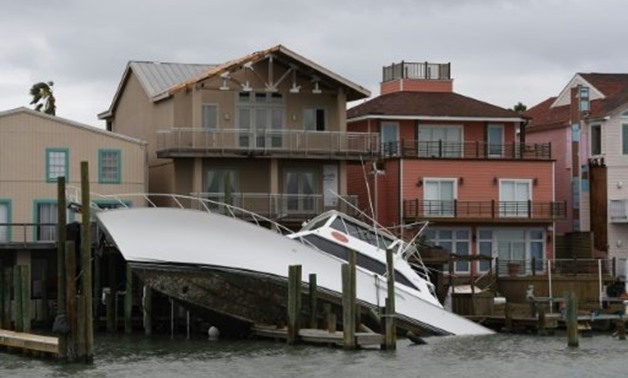
Harvey slammed into the Texas coast late Friday as a Category Four hurricane, bringing lashing rain and sustained winds of 130 miles
Houston - 29 August 2017: Monster storm Harvey slammed into the US Gulf Coast three days ago, tearing down homes and businesses before dumping what meteorologists said was an "unprecedented" nine trillion gallons of rainfall inland.
Here is what we know about the deadly storm, which has devastated swathes of Texas and is continuing to linger over the area:
Harvey made landfall on the Texas coast late Friday as a Category Four hurricane, bringing lashing rain and sustained winds of 130 miles (215 kilometers) per hour.
The National Hurricane Center called it the biggest rainstorm on record, with rainfall potentially reaching 50 inches (127 centimeters) in some places, including in Houston, the fourth-largest city in America.
The city with a population of 2.3 million people -- and more than six million in the greater metropolitan area -- did not order evacuations ahead of the storm. Authorities have scrambled to provide help as the storm flooded streets and homes, forced the evacuation of hospitals and closed two major airports.
To make matters worse, Harvey was hovering on the Texas coast Monday, sucking up more precipitation. It is now threatening to turn eastward and make a new landfall on Wednesday before driving on to neighboring Louisiana, which was already being pelted with rain.
Authorities have not yet provided specifics on the scale of damage caused by Harvey, with Texas Governor Greg Abbott saying only that the cost of recovery was set to reach billions.
Analysts on Monday were estimating damage could end up costing between $30 and $100 billion, according to Bloomberg. Much of the economic damage will not be covered by insurance.
The Gulf of Mexico region struck by Harvey is a key US oil producing hub. About 22 percent of crude production in the Gulf of Mexico, accounting for more than 375,000 barrels a day, was shut down.
Abbott said the oil industry was well prepared and could restart operations within one or two weeks.
Multiple ports along the Texas Gulf Coast were also shut, including the Port of Houston which is the second busiest in the country in terms of total tonnage.
The confirmed death toll stands at three, but is expected to rise as rescuers reach some of the hardest-hit areas, with hundreds of people still marooned on flooded streets in and around the city of Houston alone.
More than 2,000 people have been brought to rapidly-filling shelters in America's fourth largest city and the Federal Emergency Management Agency (FEMA) said it expected more than 30,000 people would need temporary shelter.
"While the hurricane-force winds have diminished, I want to stress that we are not out of the woods yet, not by a long shot," Homeland Security acting secretary Elaine Duke said at a news conference.
"Life-threatening flooding will occur over a large portion of south-central and southeast Texas in the coming days. Rivers won't crest until later this week."
FEMA chief Brock Long said search and rescue missions were ongoing across a swath of Texas encompassing as many as 50 counties.
Days after Harvey made landfall, rescue efforts were being carried out by a combination of federal and local authorities as well as by ordinary people.
Abbott on Monday mobilized the entire Texas National Guard, bringing the number of troops deployed to 12,000.
Vice President Mike Pence meanwhile said the federal government had mobilized 8,000 officials in the area, shipping more than 1.2 million meals and a million liters of water.
In Houston, some residents were stranded on rooftops as murky floodwaters forced them out of their homes.
Harvey was still classified as a tropical storm on Monday, with winds of up to 40 miles per hour (64 kilometers per hour) that were grounding some rescue flights.
Authorities at every level of government have stressed that the disaster is continuing to unfold, with Long saying the work was still at a "life sustaining" stage.
"We're not at recovery yet. We're thinking and planning for recovery," he said in Washington.
Some 450,000 people could ultimately require some form of disaster assistance, Long said.
In the meantime, first responders were trying to get through the backlog of emergency calls, before Harvey hits Houston again.
The Army Corps of Engineers opened release valves behind two dams straining with floodwaters, amid concerns they could be overtopped.
Houston's police chief warned would-be troublemakers to stay away, saying four people have been arrested for looting and that law enforcement resources were being expanded to keep order.
From an environmental standpoint, experts were warning of bacterial infections brought on by sewage-laden floodwaters and the potential for contaminated drinking water.


Comments
Leave a Comment